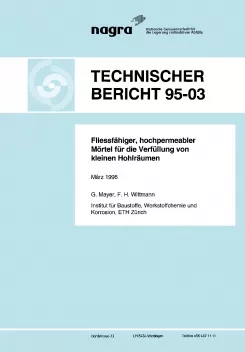
Technischer Bericht NTB 95-03
Fliessfähiger, hochpermeabler Mörtel für die Verfüllung von kleinen Hohlräumen
Prior to disposal, most of the low-and intermediate-level wastes are packaged in steel drums which are then placed in disposal containers and emplaced in the repository cavems. The voids between the drums in the disposal containers will be infilled with a porous free-flowing mortar called "mortar 2" (M2), while the vertical voids between the disposal containers itself and the disposal containers and the cavem walls will be backfilled with a mortar called "mortar 1" (M1) which is very porous but not freeflowing. A possible arrangement of the disposal containers and the zones of application of the different mortars are shown in figure 1.
Both mortars should have a high gas permeability to allow gases produced when the waste corrodes or degrades to escape from the repository without any excessive build-up of pressure.
This report describes the results of laboratory experiments performed on different mixtures of mortar M2. The mortars are modified by addition of finely dispersed aluminium powder (1 – 3 ‰ of the cement weight) and have the following characteristics:
- The fresh mortar has a free-flowing consistency and the reaction of the aluminium powder in this alkaline milieu produces hydrogen gas (1.67 l per g aluminium). This leads to formation of pores and ensures the desired high gas permeability. A large component of the hydrogen gas produced can escape from the fresh mortar and it should thus be ensured that there is sufficient ventilation during mortar production.
- The hardened mortar has inhomogeneous properties. The weight of the mortar compresses the gas bubbles which are present in the fresh mortar and the "lower" section of the mortar element thus has less large pores than the "upper" section. The porosity is between 38 and 60 %. The compressive strength after 28 days varies between 3 and 15 N/mm2 and the permeability of the mortars reaches values between 10-14 and 10-12 m2; this is three orders of magnitude higher than the values for similar mortars without the addition of aluminium powder.
